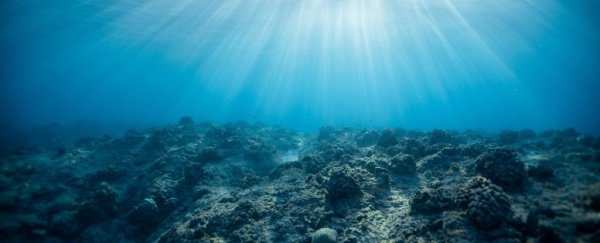Most life on Earth can be broadly split into oxygen consumers and oxygen producers.
This delicate balance of givers and takers keeps the concentration of oxygen in our planet's atmosphere around 21 percent. And, yet, that wasn't always the case.
In the first few billion years of Earth's existence, oxygen was relatively scarce. Then, out of seemingly nowhere, the diatomic gas suddenly increased.
More oxygen was being given than taken, but how and why did that occur?
Scientists have pondered these mysteries for years now, and researchers at the Massachusetts Institute of Technology (MIT) have a new hypothesis. Perhaps some microbes were toeing the line between oxygen producers and consumers.
Microbes in the deep ocean are known to use oxygen to break down organic matter. But what if another microbe was taking a bite out of the ocean's oxygen before other consumers could get to it?
Theoretically, if a microbe only partially oxidized organic matter, there's a good chance the leftovers will chemically bind to minerals in the ocean sediment.
This oxygen burial would keep the organic material from being more fully oxidized while being broken down by more voracious microbes. As such, the oxygen would have a chance of building up in the water before trickling out into the atmosphere. Then, the ocean can absorb it again, creating a positive feedback loop.
"That led us to ask, is there a microbial metabolism out there that produced POOM (partially oxidized organic matter)?" recalls geobiologist Gregory Fourier.
As it turns out, there was. Searching the scientific literature, Fourier and his colleagues – Haitao Shang and Daniel Rothman – landed on a bacterial group known as SAR202.
This modern group of bacteria can partially oxidize organic matter in today's deep oceans. It can do this via an enzyme known as Baeyer-Villiger monooxygenase, or BVMO.
When tracing the genetic lineage of this enzyme, the authors found it existed among microbes that evolved before the great oxidation event.
What's more, spikes in early Earth oxygen appear to coincide with this gene's expansion. In other words, as the ability to partially oxidize organic material spread among microbes, there was also an increase in atmospheric oxygen levels.
The timing could be a coincidence, or it could imply that microbes with these genes helped kick off the great oxidation event.
As oxygen became more available in the environment, it probably supported the diversification of similar oxidative metabolisms in other microbes.
"This may appear counter-intuitive: oxidative metabolic processes, after all, consume O2," the authors write.
"A potentially important positive feedback nevertheless lies in the interaction of oxidized metabolic products with minerals in sedimentary environments."
Partially oxidized organic matter is bound more tightly to mineral surfaces in ocean sediments. This means the enzymes of microbes can't get to it as easily.
The buried oxygen can therefore persist over large geologic timescales, ultimately driving oxygen accumulation in Earth's oceans and atmosphere.
At some point, this positive feedback loop would have balanced out at 21 percent oxygen in the atmosphere – probably when enough life forms evolved to start consuming the element.
The scale between oxygen consumers and producers has been settled ever since.
Another recent study supports this hypothesis, suggesting the burial of organic matter in a low oxygen environment played a bigger role in Earth's great oxygenation event than we thought.
Instead of photosynthesizing bacteria oxygenating the atmosphere and then the ocean, what if minerals in the ocean oxygenated the atmosphere?
Further research is needed to flesh these ideas out, but so far, they seem like possible explanations.
"Proposing a novel method, and showing evidence for its plausibility, is the first but important step," says Fournier. "We've identified this as a theory worthy of study."
The study was published in Nature Communications.
